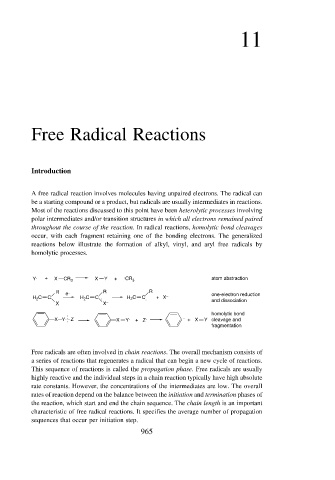Page 981 - Advanced Organic Chemistry Part A - Structure and Mechanisms, 5th ed (2007) - Carey _ Sundberg
P. 981
11
Free Radical Reactions
Introduction
A free radical reaction involves molecules having unpaired electrons. The radical can
be a starting compound or a product, but radicals are usually intermediates in reactions.
Most of the reactions discussed to this point have been heterolytic processes involving
polar intermediates and/or transition structures in which all electrons remained paired
throughout the course of the reaction. In radical reactions, homolytic bond cleavages
occur, with each fragment retaining one of the bonding electrons. The generalized
reactions below illustrate the formation of alkyl, vinyl, and aryl free radicals by
homolytic processes.
Y . + X CR 3 X Y + . CR 3 atom abstraction
R e . R R one-electron reduction
H 2 C C H 2 C C . H 2 C C . + X – and dissociation
X X –
homolytic bond
XY Z X Y . + Z . . + X Y cleavage and
fragmentation
Free radicals are often involved in chain reactions. The overall mechanism consists of
a series of reactions that regenerates a radical that can begin a new cycle of reactions.
This sequence of reactions is called the propagation phase. Free radicals are usually
highly reactive and the individual steps in a chain reaction typically have high absolute
rate constants. However, the concentrations of the intermediates are low. The overall
rates of reaction depend on the balance between the initiation and termination phases of
the reaction, which start and end the chain sequence. The chain length is an important
characteristic of free radical reactions. It specifies the average number of propagation
sequences that occur per initiation step.
965

